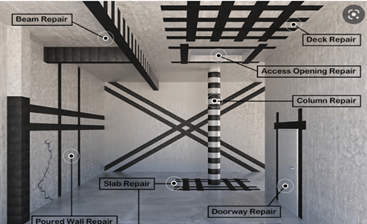About us | Email: info@wolf-fix.com


1 Introduction
The use of carbon fiber reinforced materials to repair and reinforce concrete structures is a new construction method developed recently. It uses the excellent tensile strength of carbon fiber materials to achieve the purpose of enhancing the bearing capacity and stiffness of components. The carbon fiber reinforcement method can be used for bending and shearing reinforcement of bridge concrete structures, and is widely used in various industrial and civil buildings and structures for shockproof, crack-proof, and anti-corrosion reinforcement.
2. The reinforcement principle of carbon fiber
Carbon fiber is widely used in bridge engineering. The basic principle of its reinforcement is to pre-impregnate carbon fiber with high tensile strength with epoxy resin to form a composite reinforcement material; use epoxy resin adhesive to paste it along the direction of tension or perpendicular to the crack direction. On the structure to be reinforced, a new complex is formed, so that the reinforced paste material and the original reinforced concrete are subjected to the same force, and the crack resistance or shear resistance of the structure is increased to improve the strength, stiffness and crack resistance of the structure. and prolongation.
3. Characteristics of carbon fiber reinforcement
Carbon fiber material has light weight, convenient and quick construction, and does not increase structural load; high strength, can be flexibly used for bending resistance, closed hoops and shear reinforcement; good flexibility, not limited by structural shape; good durability, chemical corrosion and Strong ability of harsh environment and climate change; at the same time, high temperature resistance, creep resistance, abrasion resistance, and earthquake resistance are good; it is widely used in concrete components, steel structures, and wooden structures.
4. Carbon fiber composite materials
4.1 Carbon fiber composite materials
Carbon fiber composites usually consist of fibers and a matrix. Its mechanical characteristic is that the stress-strain volume is completely linear elastic, and there is no yield point or plastic zone. Because carbon fiber materials have excellent physical and mechanical properties such as high strength, light weight, corrosion resistance, and fatigue resistance, as well as convenient on-site construction, they are ideal materials for reinforcement of old bridges. The tensile strength of carbon fiber cloth is generally 3550MPa, and the elastic modulus is 2.35×105MPa. According to the quality of carbon fiber cloth, its thickness is 0.11~0.43mm, width is 20~100cm, and coil length is 50~100m.
4.2 Adhesive material
Adhesive materials refer to a series of materials that can combine continuous fibrous carbon fibers together and at the same time bond to the concrete surface. It is guaranteed carbon fiber cloth with concrete
The key to the same work, there should be enough rigidity and strength to ensure the transmission of shear force between carbon fiber and concrete, and at the same time, there should be enough toughness to prevent the concrete from cracking.
Cracks lead to brittle bond failure. In addition, since the reinforcement of old bridges is carried out in the field, the bonding material should be able to cure under normal weather conditions, with a suitable curing time (generally guaranteed to be about 3 hours), insensitive to component content, and have suitable fluidity and viscosity. Curing shrinkage is small. Bonding materials mainly include three types of materials: primer, leveling material and impregnating resin.
5. Analysis of reinforcement force characteristics
(1) Carbon fiber cloth has a variety of unidirectional carbon fiber cloth, unidirectional carbon fiber interwoven cloth, bidirectional carbon fiber interwoven cloth and unidirectional carbon fiber laminated materials, etc., which can be selected according to different parts of the structure to be reinforced and the force characteristics and directions. Corresponding carbon fiber cloth for reinforcement.
(2) Paste the carbon fiber cloth with excellent tensile properties on the bottom surface of the girder or the inner wall of the box girder, so that it can bear the tensile force together with the steel bars arranged in the original structure, so as to improve the bearing capacity of the old bridge. Compared with other reinforcement methods, carbon fiber cloth ensures that it is under the same force as the original structure within the design load range, and it changes the stress distribution of the original structure to a minimum.
(3) Carbon fiber cloth is pasted along the main tensile stress direction of the bridge or in the direction perpendicular to the crack, and anchorage ends are set at both ends, which can restrain the cracks on the concrete surface, prevent cracks from expanding, improve the bending stiffness of components, reduce component deflection, and improve beams. power state.
(4) CFRP should be used reasonably to strengthen reinforced concrete girder bridges according to the actual situation, because when CFRP strengthens concrete members, it not only improves the flexural bearing capacity, but also affects the failure mode of the flexural members. When the amount of carbon fiber cloth is too much, the damage form of the component changes from the damage caused by the carbon fiber being pulled off to the sudden crushing of the concrete. Also because carbon fiber is a completely elastic material, it will weaken the plasticity of the steel bar when it works together with the steel bar. If the amount of carbon fiber cloth is too much, the ductility of the component will be reduced.
(5) The failure mode of the bridge structure becomes brittle after carbon fiber sheet reinforcement, and the limit state of its bearing capacity should be calculated according to 2/3 of the tensile strength of carbon fiber for flexural bearing capacity, which cannot be considered as ordinary reinforced concrete.
(6) Carbon fiber cloth can improve the shear bearing capacity of concrete beams, and its mechanism of action is similar to that of stirrups. At the same time, it can also significantly improve the deformation performance of components and enhance the deformation capacity of components.